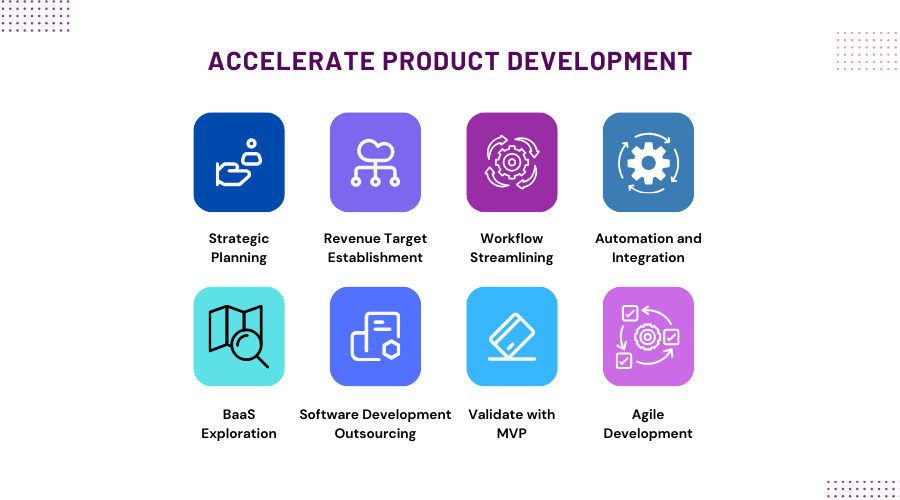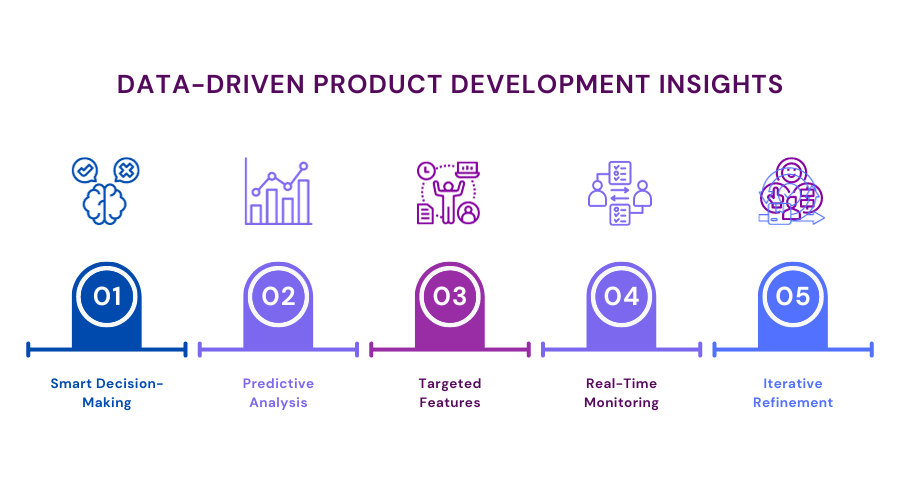How to Accelerate Your Product Development Process

Speeding up the product development process and reducing time-to-market (TTM) is essential for businesses.
Gartner’s survey found that a staggering 45% of product launches get delayed by at least a month. This alarming statistic underscores organizations’ challenges in bringing new products to market.
For businesses of all sizes, timing is everything. Releasing a product too early can lead to incomplete customer engagement. Launching late can give rivals a first-mover advantage.
Despite the challenges, only 11% of organizations can hit 100% of their internal launch targets. The root cause of this problem is the inherent complexity of the product development process. It’s a multifaceted journey, fraught with unforeseen challenges and variables.
Businesses must understand the typical timeframes involved in bringing each product to market to navigate the product development process seamlessly and deliver value to customers faster. This knowledge can construct more precise product development timelines and launch schedules.
In this article, we will explore strategies and tactics to expedite the product development process, reduce TTM, and tackle organizations’ everyday problems.
Benefits of Speeding Up Product Development Process
Accelerating the product development process offers many advantages for businesses across various industries. This proactive approach to innovation and production can significantly enhance competitiveness and foster growth. Here are some of the key benefits:
- Faster Time-to-Market: Accelerating the product development process reduces the time for a concept to become a tangible product. It will allow companies to bring their offerings to the market faster than their competitors, gaining a crucial edge.
- Cost Efficiency: A more efficient development process can lead to cost savings. By minimizing the time and resources required for product development, companies can allocate their budget more wisely and invest in other business areas.
- Adaptability: Accelerated product development enables businesses to respond swiftly to changing market conditions and customer demands. This agility is invaluable in dynamic industries where trends and requirements evolve rapidly.
- Increased Innovation: Speeding up development encourages an organization’s innovation culture. Teams are motivated to generate new ideas and experiment with different approaches, fostering creativity and a competitive advantage.
- Improved Risk Management: Swift development cycles allow for early identification and mitigation of potential issues or roadblocks in the product development process. This proactive approach helps reduce risks and ensures smoother project execution.
- Enhanced Customer Satisfaction: Quickly delivering innovative products can impress and delight customers, increasing customer loyalty and positive word-of-mouth, ultimately driving business growth.
- Market Leadership: Companies that consistently introduce new products or updates faster than their competitors often get perceived as leaders in their respective markets. This perception can attract new customers and partners.
- Streamlined Operations: Faster development processes often necessitate streamlining and optimizing internal operations. It leads to improved efficiency and productivity throughout the organization.
- Economies of Scale: Accelerated product development can lead to larger production runs, reducing costs per unit. It can result in improved profit margins.
- Global Expansion: The ability to develop and launch products quickly can facilitate expansion into new markets. Speedy adaptation to local requirements can be a significant advantage when going global.
What Most People Don’t Know About Speed to Market
When it comes to speed to market, several lesser-known factors can truly make a difference in the success of a product or service launch. These elements often go unnoticed but are essential to a company’s competitiveness in the fast-paced digital age.
- The Power of Agile Methodology: Agile development methodologies are not merely buzzwords but essential tools for accelerating the path to market. Agile practices emphasize flexibility, collaboration, and iterative progress. By fostering an environment that allows for quick adjustments and continual improvement, businesses can swiftly bring their offerings to market.
- Cross-Functional Collaboration: The notion that a single department can drive a product to market with optimal efficiency is a misconception. Successful speed to market often hinges on cross-functional collaboration. Different departments must work seamlessly together, breaking down silos to create a smoother and accelerated product development process.
- Rapid Prototyping: Developing prototypes quickly and soliciting end-user feedback can be a game-changer. It minimizes the risk of heavily investing in a concept that may not align with market demands. Rapid prototyping allows businesses to fine-tune their offerings before the full-scale launch, increasing the chances of success.
- Data-Driven Decision-Making: Many businesses fail to harness the full potential of data and analytics. Leveraging data from market research to product design and marketing strategies is pivotal. It provides valuable insights that can guide informed decisions, ultimately expediting the path to market.
- Market Timing: Timing is a critical factor that often goes underappreciated. Knowing when to introduce a product or service can significantly impact its success. It involves understanding market trends, consumer behavior, and external factors that might influence the market’s reception.
- Risk Management: Speed to market should not get equated with recklessness. What’s less recognized is the meticulous risk assessment and mitigation that accompanies rapid product launches. Companies that excel in this area effectively identifying and mitigating risks, tend to fare better in the long run.
- Customer-Centric Approach: Speed to market is not merely about rapid product development; it’s about swiftly delivering what customers want. A customer-centric approach, founded on a deep understanding of their needs and preferences, is fundamental to success.
- Adaptation and Flexibility: The business landscape faces unforeseen challenges and market shifts. Being adaptable and flexible is essential. Businesses that can change course rapidly when needed will have a greater chance of success and survival in changing environments.

How to Accelerate Your Product Development Process
The critical steps will help you accelerate the product development process.
- Develop a strategic plan
- Establish revenue targets
- Streamline workflow organization
- Leverage automation and integration
- Explore Backend-as-a-Service (BaaS) solutions
- Consider software development outsourcing
- Validate product viability with an MVP
- Conquering development challenges with agile
- Increasing data availability for better insights
Step 1 – Develop a Strategic Plan
It is crucial to have a well-thought-out plan and ensure its implementation to accelerate the product development process effectively. Begin by revisiting your idea, engaging in discussions with your team and experts, and conducting a thorough analysis to make an informed decision.
Create a comprehensive timeline, identifying key dates and milestones while considering the specific requirements of your product to estimate the approximate time to market.
When developing an innovative product, it is essential to recognize that delays often stem from overly complex technical processes that exceed initial expectations. Prioritizing a swift outcome during this initial phase is critical rather than striving for perfection. Typically, any technical glitches and feature gaps can get addressed after conducting the first round of testing and launching a prototype.
Additionally, active involvement is crucial. It is a common misconception to deviate from the process and solely rely on the team to carry out their tasks. By maintaining careful oversight at every stage of production, you can stay well-informed and promptly address any unforeseen challenges or emergencies that may arise.
Chisel’s Roadmap pillar aims exclusively to assist you in crafting a high-quality, efficient strategic plan. You’ll discover a range of tools, from timeline tracking and resource allocation to release planning, all at your disposal.
Sign up for a free trial of Chisel today
Step 2 – Establish Revenue Targets
Time-to-market (TTM) is important because it can significantly impact revenue. If you can launch your product sooner, you’ll start generating revenue sooner.
However, there’s a catch: shortening TTM can significantly increase costs. That’s why it’s important to balance speed and cost.
One way to do this is to set clear revenue goals and keep them in mind throughout the TTM process. It will help you prioritize your work and focus on essential features. You should also avoid adding too many features or polishing your product prematurely. Instead, focus on getting a working product to market quickly and then iterate based on user feedback.
Rapid prototyping and rapid iteration are other ways to reduce TTM without increasing costs. It means creating a preliminary version of your product for testing and feedback and then making improvements quickly. This approach allows you to identify and solve problems early on, saving you time and money in the long run.
Step 3 – Optimize Organizational Workflows
Make use of pertinent services for project management success. You may better manage the performance of your team by using this tool. Your workers will be able to adhere to the plan and fulfill deadlines with the help of interactive boards, statistics, and easy time monitoring.
Agile development methods, which incorporate Scrum, Kanban, and other frameworks, are among the best. It calls for ongoing collaboration, constructive criticism, and fast change adaptability.
It enables you to make continuous improvements to the product, guaranteeing that it remains relevant to the needs of the intended market. You advance and bring your product to market more quickly as a result.
Chisel offers a Kanban Board that simplifies workflow management, making it a breeze.
Step 4 – Leverage Automation and Integration
One of the methods for accelerating time to market is automation. Technology has emerged as a lifesaver when human error can result in complications. It relieves overburdened employees with the project and finds answers to issues people would otherwise become bogged down on.
Automation is a way to carry out regular, repetitive operations. It helps in the management of the fundamental product development cycles.
Another strategy for reducing time to market is integration. One small project in its early stages of development may have a significant amount of data that is continuously increasing. Arrange everything into one location and keep it updated to prevent misunderstandings and repeated checks within the team.
Step 5 – Look at Solutions for Backend-as-a-Service (BaaS)
Backend-as-a-Service (BaaS) can help accelerate the product development process in the following ways:
- No need to build and maintain backend infrastructure: BaaS providers provide developers with a pre-built and managed backend infrastructure, eliminating the need to spend time and resources setting up and maintaining servers, databases, and other backend components. It can free up developers to focus on building their products’ core features and functionality.
- Pre-written backend services: BaaS providers offer various pre-written backend services, such as user authentication, data storage, remote updating, and push notifications. It eliminates the need for developers to write these services from scratch, which can save a significant amount of time.
- Scalability and reliability: BaaS providers offer scalable and reliable backend infrastructure, which can help businesses scale their products as needed quickly. It can be especially important for businesses launching new products or experiencing rapid growth.
- Easy to use and integrate: BaaS platforms are typically easy to use and integrate with existing front-end applications. This capability makes it easy for developers to start with BaaS and quickly launch their products.
Step 6 – Use Software Development Outsourcing to Your Advantage
Outsourcing software development can be a smart way to speed up product development and get your product to market faster. It can also save you money and allow you to refocus your team on their core competencies.
The basic idea is to delegate some of the development work to a team of external specialists and have dedicated development team who can help you meet your deadlines and even work on multiple areas of the project simultaneously. It frees up your team to focus on what they do best and allocate resources where they will have the most significant impact.
Outsourcing partners can also bring skills, expertise, and experience to the table that your team may lack, especially in specific technologies and industries.
Additionally, outsourcing is a flexible way to scale your team up or down without committing to hiring new developers full-time. It can help to reduce your risk and save you money.
Step 7- Confirming Product Feasibility Using a Minimum Viable Product
Launching a new product is an exciting time for any business, but it can also be daunting. There are many things to consider, from product development to marketing and sales. And one of the biggest challenges is getting your product to market quickly and efficiently.
This is where a Minimum Viable Product (MVP) can be beneficial. A well-executed minimum viable product (MVP) aims to extract valuable insights and knowledge while minimizing the resources, effort, and costs invested.
An MVP is a simple version of your product with just enough features to solve a critical problem for your target users. It’s an excellent approach to quickly verify your product idea and get feedback from potential customers before investing extensively in development.
Here’s how an MVP can help you reduce time to market:
- You can launch your product faster. By focusing on the core features of your product, you can develop and launch an MVP in a fraction of the time it would take to establish a fully-fledged product.
- You can get feedback from users early on. Once you have a working MVP, you can get feedback from your target users as soon as possible. This feedback will help you to identify and fix any potential problems with your product before it’s too late.
- You can iterate quickly. Based on the feedback you receive from users, you can iterate on your MVP and make improvements. It allows you to develop a product that your users love quickly.
Step 8 – Conquering Development Challenges with Agile
Did you know that 61% of companies employ agile methodologies for software development and organization-wide digital transformation?
Agile development is an iterative approach to product development that focuses on delivering value to customers early and often. It is a highly collaborative process that involves cross-functional teams working together to build and test products in short cycles called sprints.
Agile development can help accelerate product development in the following ways:
- Early and frequent feedback: Agile teams get feedback from customers early and often, which helps them to identify and fix problems quickly. It can help to prevent costly rework and delays.
- Prioritization: Agile teams focus on developing the most critical features first. It means that customers can start using the product sooner and provide feedback on the most essential features.
- Flexibility: Agile teams can adapt to changes in requirements quickly and easily. It is because they work in short sprints and constantly get customer feedback.
- Continuous delivery: The teams continuously deliver working software to customers. It means that customers can start using the product sooner and provide feedback on the most essential features.
Chisel is the number of agile product management software designed specifically for you. Do you want to collect user feedback in real-time? Do you want to ensure great collaboration? Chisel has it all.
Sign up for a free trial of Chisel today
Step 9 – Increasing Data Availability for Better Insights

Data availability is the ability to access and use data when and where it is needed. It is essential for businesses of all sizes but especially important for developing new products.
Improving data availability can help reduce time to market during product development in the following ways:
- Faster decision-making: When data is readily available, teams can make faster decisions about product development. They don’t have to waste time searching for or collecting data.
- Reduced rework: When teams can access accurate and up-to-date data, they are less likely to make mistakes. It can help to minimize rework and delays.
- Improved collaboration: When data is shared and accessible to all stakeholders, teams can collaborate more effectively. It can help to accelerate the product development process.
Key Takeaways
Time to market is the make-or-break phase of product development. It’s the race to get your product to market before the competition and customer demand shifts. If you’re too slow, you risk losing market share and profitability.
So how can you speed up time to market? We have looked at multiple steps, from developing a visionary strategic plan to making the agile development process your best friend.
If you’re prepared to turn your tech product concept into a reality, your search ends here with Chisel. Our seasoned experts are ready to assist you through every phase of the development process, providing our services on a subscription basis. We recognize the significance of a prompt product launch, and we’re fully equipped to expedite your product’s development. Let’s collaborate to transform your idea into a tangible product!
